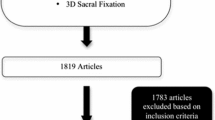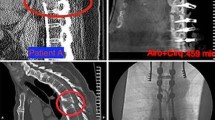Abstract
Purpose
Navigation is emerging as a useful adjunct in percutaneous, minimally invasive spinal surgery (MIS). The aim of this study was to compare C-Arm navigated, O-Arm navigated and conventional 2D-fluoroscopy assisted MIS thoracic and lumbosacral spine fixation techniques in terms of operating time, radiation exposure and accuracy of pedicle screw (PS) placement.
Methods
Retrospective observational study of 152 consecutive adults who underwent MIS fixations for spinal instability: 96 2D-fluoroscopy assisted, 39 3D-C-Arm navigated and 27 using O-Arm navigated.
Results
O-Arm navigation significantly reduced PS misplacement (1.23%, p) compared to 3D-C-Arm navigation (7.29%, p = 0.0082) and 2D-fluoro guided placement (5.16%, p = 0379). 3D-C-Arm navigation was associated with lower procedural radiation exposure of the patient (0.4 mSv) than O-Arm navigation (3.24 mSv) or 2D-fluoro guidance (1.5 mSv). Operative time was comparable between three modalities.
Conclusions
O-Arm navigation provides greater accuracy of percutaneous instrumentation placement with an acceptable procedural radiation dose delivered to the patients and comparable operative times.
Graphical abstract
These slides can be retrieved under Electronic Supplementary material.



Similar content being viewed by others
References
Amato V, Giannachi L, Irace C, Corona C (2010) Accuracy of pedicle screw placement in the lumbosacral spine using conventional technique: computed tomography postoperative assessment in 102 consecutive patients. J Neurosurg Spine 12:306–313
Aoude AA, Fortin M, Figueiredo R, Jarzem P, Ouellet J, Weber MH (2015) Methods to determine pedicle screw placement accuracy in spine surgery: a systematic review. Eur Spine J 24:990–1004
Bourgeois AC, Faulkner AR, Bradley YC, Pasciak AS, Barlow PB, Gash JR et al (2015) Improved accuracy of minimally invasive transpedicular screw placement in the lumbar spine with 3-dimensional stereotactic image guidance: a comparative meta-analysis. J Spinal Disord Tech 28:324–329
Castro WH, Halm H, Jerosch J, Malms J, Steinbeck J, Blasius S (1996) Accuracy of pedicle screw placement in lumbar vertebrae. Spine (Phila Pa 1976) 21:1320–1324
Costa F, Dorelli G, Ortolina A, Cardia A, Attuati L, Tomei M et al (2015) Computed tomography-based image-guided system in spinal surgery: state of the art through 10 years of experience. Neurosurgery 11:59–68
Gelalis IG, Paschos NK, Pakos EE, Politis AN, Arnaoutoglou CM, Karageorgos AC et al (2012) Accuracy of pedicle screw placement: a systematic review of prospective in vivo studies comparing free hand, fluoroscopy guidance and navigation techniques. Eur Spine J 21:247–255
Gertzbein SD, Robbins SE (1990) Accuracy of pedicular screw placement in vivo. Spine (Phila Pa 1976) 15:11–14
Goldstein CL, Macwan K, Sundararajan K, Rampersaud RY (2014) Comparative outcomes of minimally invasive surgery for posterior lumbar fusion. Clin Orthop Relat Res 472:1727–1737
Government of the United Kingdom of Great Britain and Northern Ireland (2011) website page: https://www.gov.uk/government/publications/ionising-radiation-dose-comparisons/ionising-radiation-dose-comparisons
Holly LT, Foley KT (2003) Intraoperative spinal navigation. Spine (Phila Pa 1976) 28:S54–S61
Kim CW, Lee YP, Taylor W, Oygar A, Kim WK (2008) Use of navigation-assisted fluoroscopy to decrease radiation exposure during minimally invasive spine surgery. Spine J 8:584–590
Kim DY, Lee SH, Chung SK, Lee HY (2005) Comparison of multifidus muscle atrophy and trunk extension muscle strength: percutaneous versus open pedicle screw fixation. Spine (Phila Pa 1976) 30:123–129
Kraus M, Weiskopf J, Dreyhaupt J, Krischak G, Gebhard F (2015) Computer-aided surgery does not increase the accuracy of dorsal pedicle screw placement in the thoracic and lumbar spine: a retrospective analysis of 2003 pedicle screws in a level I trauma center. Glob Spine J 5:93–101
Ling JM, Dinesh SK, Pang BC, Chen MW, Lim HL, Louange DT et al (2014) Routine spinal navigation for thoraco–lumbar pedicle screw insertion using the O-Arm three-dimensional imaging system improves placement accuracy. J Clin Neurosci 21:493–498
Mason A, Paulsen R, Babuska Rajpal S, Burneikiene S, Nelson EL et al (2014) The accuracy of pedicle screw placement using intraoperative image guidance systems. J Neurosurg Spine 20:196–203
Mendelsohn D, Strelzow J, Dea N, Ford NL, Batke J, Pennington A et al (2016) Patient and surgeon radiation exposure during spinal instrumentation using intraoperative computed tomography-based navigation. Spine J 16:343–354
Nimjee SM, Karikari IO, Hardin AB, Choi J, Powers CJ, Brown CR et al (2015) Safe and accurate placement of thoracic and thoracolumbar percutaneous pedicle screws without image-navigation. Asian J Neurosurg 4:272–275
Rivkin MA, Yocom SS (2014) Thoracolumbar instrumentation with CT-guided navigation (O-Arm) in 270 consecutive patients: accuracy rates and lessons learned. Neurosurg Focus 36:E7
Ruatti S, Dubois C, Chipon E, Kerschbaumer G, Milaire M, Moreau-Gaudry A et al (2016) Interest of intra-operative 3D imaging in spine surgery: a prospective randomized study. Eur Spine J 25:1738–1744
Santos ER, Sembrano JN, Yson SC, Polly DW (2015) Comparison of open and percutaneous lumbar pedicle screw revision rate using 3-D image guidance and intraoperative CT. Orthopedics 38:e129–e134
Shin BJ, James AR, Njoku IU, Härtl R (2012) Pedicle screw navigation: a systematic review and meta-analysis of perforation risk for computer-navigated versus freehand insertion. J Neurosurg Spine 17:113–122
Skovrlj B, Belton P, Zarzour H, Qureshi SA (2015) Perioperative outcomes in minimally invasive lumbar spine surgery: a systematic review. World J Orthop 6:996–1005
The international Commission on Radiological Protection, Publication 103 (2007) http://www.icrp.org/publication.asp?id=ICRP%20Publication%20103
Tian N, Huang Q, Zhou P, Zhou Y, Wu R, Lou Y et al (2011) Pedicle screw insertion accuracy with different assisted methods: a systematic review and meta-analysis of comparative studies. Eur Spine J 20:846–859
Tian W, Zeng C, An Y, Wang C, Liu Y, Li J (2016) Accuracy and postoperative assessment of pedicle screw placement during scoliosis surgery with computer-assisted navigation: a meta-analysis. Int J Med Robot. https://doi.org/10.1002/rcs.1732
Van de Kelft E, Costa F, Van der Planken D, Schils F (2012) A prospective multicenter registry on the accuracy of pedicle screw placement in the thoracic, lumbar, and sacral levels with the use of the O-Arm imaging system and stealth station navigation. Spine (Phila Pa 1976) 37:E1580–E1587
Waschke A, Walter J, Duenisch P, Reichart R, Kalff R, Ewald C (2013) CT-navigation versus fluoroscopy-guided placement of pedicle screws at the thoracolumbar spine: single center experience of 4500 screws. Eur Spine J 22:654–660
Wood MJ, Mannion RJ (2010) Improving accuracy and reducing radiation exposure in minimally invasive lumbar interbody fusion. J Neurosurg Spine 12:533–539
Wood MJ, McMillen J (2014) The surgical learning curve and accuracy of minimally invasive lumbar pedicle screw placement using CT based computer-assisted navigation plus continuous electromyography monitoring—a retrospective review of 627 screws in 150 patients. Int J Spine Surg 1:8
Yang BP, Wahl MM, Idler CS (2012) Percutaneous lumbar pedicle screw placement aided by computer-assisted fluoroscopy-based navigation: perioperative results of a prospective, comparative, multicenter study. Spine (Phila Pa 1976) 37:2055–2060
Author information
Authors and Affiliations
Corresponding author
Ethics declarations
Conflict of interest
The authors report no conflict of interest concerning the materials or methods used in this study or the findings specified in this paper.
Electronic supplementary material
Below is the link to the electronic supplementary material.
Rights and permissions
About this article
Cite this article
Tajsic, T., Patel, K., Farmer, R. et al. Spinal navigation for minimally invasive thoracic and lumbosacral spine fixation: implications for radiation exposure, operative time, and accuracy of pedicle screw placement. Eur Spine J 27, 1918–1924 (2018). https://doi.org/10.1007/s00586-018-5587-z
Received:
Revised:
Accepted:
Published:
Issue Date:
DOI: https://doi.org/10.1007/s00586-018-5587-z




